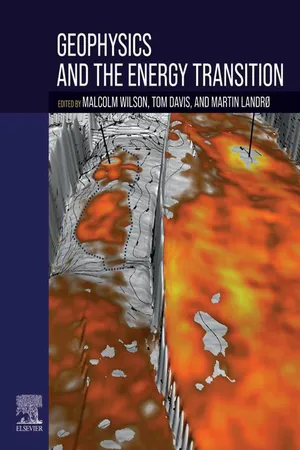
- 475 pages
- English
- ePUB (mobile friendly)
- Available on iOS & Android
eBook - ePub
Geophysics and the Energy Transition
About this book
Geophysics and the Energy Transition involves four sections: What is the Energy Transition and why storage so important; selecting sites for storage; advanced monitoring technology; and moving forward to integrating Carbon Capture and Storage (CCS) within the Energy Transition. Geophysics will also play a role in finding and developing alternatives to fossil fuels such as natural hydrogen and geothermal using much of the knowledge gained from the CO2 storage industry. To provide the public and others with the confidence to move forward with a structured and cost-effective energy transition, this book provides the necessary evidence that we can store CO2 safely and effectively and use this as a significant component of the energy transition.?We can also find and store new energy sources.
Geophysics and the Energy Transition is written by experts in the field who have practiced the science and engineering associated with the subsurface for years. CCS is an integral component of the new energy transition but the application of Geophysics in the future will extend well beyond CCS if we are going to transition successfully to a carbon neutral environment. Science, engineering, and technology applications are important for site selection, characterization and monitoring to assure safe storage in the subsurface and energy sustainability in the future.?
- Presents an overview of the available technology, along with specific applications and scenarios in which to use the technology?
- Features case studies to provide practical applications for those geoscientists and engineers in the energy industry?
- Includes an overview to provide context for the energy transition?
Frequently asked questions
Yes, you can cancel anytime from the Subscription tab in your account settings on the Perlego website. Your subscription will stay active until the end of your current billing period. Learn how to cancel your subscription.
At the moment all of our mobile-responsive ePub books are available to download via the app. Most of our PDFs are also available to download and we're working on making the final remaining ones downloadable now. Learn more here.
Perlego offers two plans: Essential and Complete
- Essential is ideal for learners and professionals who enjoy exploring a wide range of subjects. Access the Essential Library with 800,000+ trusted titles and best-sellers across business, personal growth, and the humanities. Includes unlimited reading time and Standard Read Aloud voice.
- Complete: Perfect for advanced learners and researchers needing full, unrestricted access. Unlock 1.4M+ books across hundreds of subjects, including academic and specialized titles. The Complete Plan also includes advanced features like Premium Read Aloud and Research Assistant.
We are an online textbook subscription service, where you can get access to an entire online library for less than the price of a single book per month. With over 1 million books across 1000+ topics, we’ve got you covered! Learn more here.
Look out for the read-aloud symbol on your next book to see if you can listen to it. The read-aloud tool reads text aloud for you, highlighting the text as it is being read. You can pause it, speed it up and slow it down. Learn more here.
Yes! You can use the Perlego app on both iOS or Android devices to read anytime, anywhere — even offline. Perfect for commutes or when you’re on the go.
Please note we cannot support devices running on iOS 13 and Android 7 or earlier. Learn more about using the app.
Please note we cannot support devices running on iOS 13 and Android 7 or earlier. Learn more about using the app.
Yes, you can access Geophysics and the Energy Transition by Malcolm Wilson,Tom Davis,Martin Landro in PDF and/or ePUB format, as well as other popular books in Physical Sciences & Geophysics. We have over one million books available in our catalogue for you to explore.
Information
Table of contents
- Geophysics and the Energy Transition
- Chapter 1 Introduction to the energy transition
- Chapter 2 Economic enablement of carbon capture and storage for the low carbon energy transition
- Chapter 3 A survey of carbon capture and storage cost and storage availability
- Chapter 4 Energy transition: a reservoir engineering perspective
- Chapter 5 Preventing CO2 from fossil fuels from reaching the atmosphere
- Chapter 6 Critical reservoir parameters for safe, secure, and long-term storage learned from the many lessons of the past for selection of permanent geological storage sites
- Chapter 7 The need for integrated reservoir characterization in carbon capture and storage
- Chapter 8 CO2 messes with rock physics
- Chapter 9 The geochemistry of carbon capture and storage with implications for hydromechanical feedbacks and geophysical monitoring☆
- Chapter 10 The geomechanics of carbon storage
- Chapter 11 Geophysical technologies for CO2 monitoring
- Chapter 12 Advances in coupled passive and active seismic monitoring for large-scale geologic carbon storage projects
- Chapter 13 New tools for quantitative data interpretation
- Chapter 14 Multiwell DAS VSP monitoring of a small-scale CO2 injection: experience from the Stage 3 Otway Project
- Chapter 15 Next generation geophysical sensing: exploring a new wave of geophysical technologies for the energy transition
- Chapter 16 The Aquistore deep saline carbon dioxide storage project: learnings in three key areas for planned deep saline storage projects
- Chapter 17 New carbon capture and storage projects in the Williston Basin
- Chapter 18 The challenges of energy transition and opportunities for geophysicists
- Chapter 19 Opportunities for open-source software and open science in carbon capture and storage
- Chapter 20 Advanced geophysics used in CO2 storage☆☆Editor’s Note: Mahmoud Hedefa is acknowledged for his contribution to this chapter. He is an inspirational leader to young people the world over and received Honorary Membership in the Society of Exploration Geophysics (SEG) in 2023 for his outstanding contributions to training and development of young geoscientists at Saudi Aramco.
- Afterword
- Index